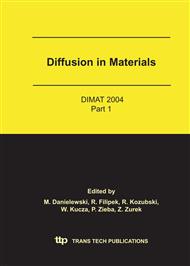p.683
p.689
p.695
p.703
p.709
p.715
p.721
p.727
p.733
Thermal Stability of NiAl-Base Coatings for High Temperature Application
Abstract:
Aluminide diffusion coatings act as a remedy against the aggressive environments in which modern aero-gas turbines operate. Platinum addition to basic aluminide coatings significantly improves the oxidation resistance of these coatings. The increase in operating temperatures of industrial energy systems and gas turbines, has led to the extensive use of coatings capable of providing improved service life. Interdiffusion plays a critical role in understanding the integrity of such coatings. The Danielewski-Holly model of interdiffusion which allows for the description of a wide range of processes (including processes stimulated by reactions at interfaces) is employed for studying of interdiffusion in the Pt-modified β-NiAl coatings. Using the inverse method the intrinsic diffusivities of Ni, Al and Pt were calculated. Such obtained diffusivities were subsequently used for modelling of thermal stability of Pt-modified aluminide coatings in air and in argon atmosphere.
Info:
Periodical:
Pages:
709-714
Citation:
Online since:
April 2005
Authors:
Keywords:
Price:
Сopyright:
© 2005 Trans Tech Publications Ltd. All Rights Reserved
Share:
Citation:


